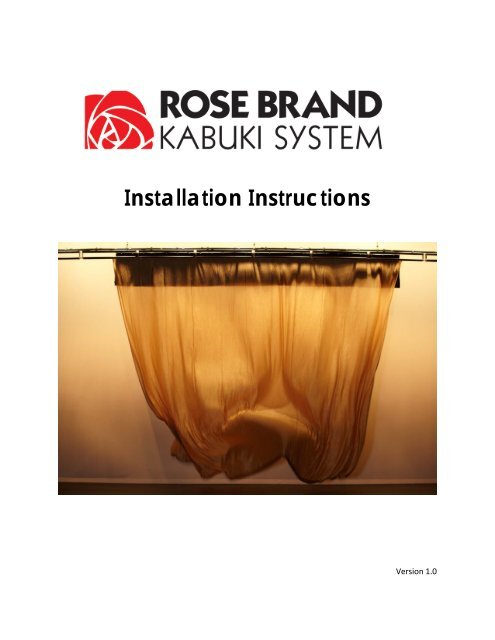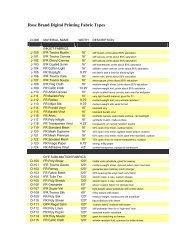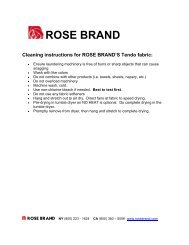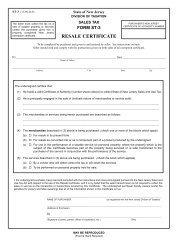PDF Kabuki System Manual - Rose Brand
PDF Kabuki System Manual - Rose Brand
PDF Kabuki System Manual - Rose Brand
Create successful ePaper yourself
Turn your PDF publications into a flip-book with our unique Google optimized e-Paper software.
Installation InstructionsVersion 1.0
Tools Needed: 7/16” Wrench or Adjustable Wrench3/16” Allen Wrench (included with Trip Mechanism)1/8” Allen Wrench (included with Trip Mechanism)Materials Recommended: Tie-LineEnd PlatePipe ClampAnd BracketCouplingTrip MechanismSupport RodCurtain RodCurtain PinLeverFigure 1: <strong>Kabuki</strong> units with and without a Trip Mechanism installed.ROSE BRAND NJ 800.223.1624 CA 800.360.5056
Step 1: Layout all <strong>Kabuki</strong> units on the floor below batten pipe or truss. Units with trip mechanisms indicated bya plastic cover go on the ends with the plastic cover facing off-stage (If trip mechanisms are not installed, seeTrip Mechanism instructions). Loosen thumb screws on all pipe clamps completely. You may also need toloosen the pipe clamp bracket nuts slightly (just enough so they slide) using a 7/16” wrench.Pipe Clamp Thumb ScrewPipe Clamp Bracket NutsFigure 2Step 2: Starting from the center of the batten pipe or truss, hang one <strong>Kabuki</strong> unit (aligned with center) andtighten the pipe clamp thumb screws and bracket bolts.Step 3: Hang another <strong>Kabuki</strong> unit adjacent to the first and tighten the pipe clamp thumb screws only.ROSE BRAND NJ 800.223.1624 CA 800.360.5056
Step 4: Align curtain pins on curtain rods with one another (i.e. all pointing up) and push units together so thecouplings are completely meshed, keeping curtain pins in alignment (refer to Figure 3). The couplings arepreset at the factory and should not need adjusting, but If the curtain pins are out of alignment, adjust the angleby loosening the set screw on one side of the coupling with an Allen wrench (included); rotate the curtain rod sothe curtain pins are in alignment and retighten the set screw. You MUST make sure all set screws are tightbefore operating <strong>Kabuki</strong> units.Coupling completelymeshedCurtain Pinsin alignmentFigure 3Step 5: Once the units are meshed together tighten the pipe clamp bracket nuts (refer to Figure 2).Step 6: Repeat steps 3, 4, and 5 until all units are in place.ROSE BRAND NJ 800.223.1624 CA 800.360.5056
Step 7: Rotate curtain rods so the lever on the end engages and is prevented from rotating. Make sure thecounterweight (sandbag) and manual release are hanging straight down and unobstructed (refer to Figure 4).<strong>Manual</strong> Release CableCounterweight andLanyard (supplied)Tie-line extensionFigure 4Step 8: If you are using a manual release as your primary method, ensure the tie-line is securely tied to eachmanual release cable. When using an electric release, plug the trip mechanisms into a light board or thependant control unit. (When using extension cords make sure to properly secure the connections with tie-lineor gaffer’s tape ensuring they will not separate. The extension cord(s) should also be supported by securingthem to the batten, truss or support rods of the <strong>Kabuki</strong> units every few feet or as necessary).Step 9: Test the units noting which tie-line, channel or button triggers the upstage and downstage curtain rods.(This is especially important for a Double <strong>Kabuki</strong> because the <strong>Kabuki</strong> bag needs to be triggered first while thecurtain needs to be triggered second; refer to Double <strong>Kabuki</strong> Instructions).Step 10: Re-engage the <strong>Kabuki</strong> curtain rod(s) into their respective latches, again making sure the counterweight(sandbag) and manual release are hanging straight down and unobstructed (refer to Figure 4).Step 11: Hang the main curtain. Starting at the center of the layout, place the center grommet of the curtainover the centermost curtain pin. Continue out to each end, placing each curtain pin along the curtain rod asneeded for each grommet.Helpful Hint: It is important to be familiar with the <strong>Kabuki</strong> units so test the functionality of the units often andbefore going “live”. Also, ensure that the curtain will be the only thing falling from above. Please rememberSAFETY FIRST!ROSE BRAND NJ 800.223.1624 CA 800.360.5056
If Double <strong>Kabuki</strong> Drop is required…Step 1: In order to conceal the <strong>Kabuki</strong> mechanism with the <strong>Kabuki</strong> bag attach <strong>Kabuki</strong> bag to the outside of thedownstage support rod and allow it to hang.Step 2: West Coast (bunch) main curtain and bring the bottom edge of the <strong>Kabuki</strong> bag up and attach to theupstage curtain rod as you did with the main curtain (refer to Figure 5).Figure 5Helpful Hint: A Double <strong>Kabuki</strong> Drop will require two trip mechanisms. These can be controlled by the handheldpendant, a light board or by using the manual release lines. In the case of the manual release lines however,there will be two lines, one on each side of the stage (stage right and stage left). Make sure they are labeled andeveryone is aware of their function and which line gets pulled first.ROSE BRAND NJ 800.223.1624 CA 800.360.5056
Install Trip MechanismIncluded with Trip Mechanism: Trip Mechanism, Mounting Bolts and Washers, Lever, Cotter Pin,Counterweight, Mounting Lanyard, 1/8” L-Hex Key and 3/16” L-Hex KeyStep 1: Remove the couplings from one side of a <strong>Kabuki</strong> unit to prep it for the trip mechanism. (Do this for asecond unit if a Double <strong>Kabuki</strong> is required).Step 2: Bolt the trip mechanism to the end plate of the <strong>Kabuki</strong> unit(s) using the four (4) bolts and washersprovided.Step 3: Slide the lever onto the shaft on the right side and align it with the curtain pins on the curtain rod andpin it into place using the cotter pin provided.Step 4: Install the counterweight by threading the lanyard provided through the hole in middle of the lever andhooking the counterweight’s quick-link onto both loop ends. Close the quick-link by tightening the nut andallow the counterweight to hang down unobstructed.Step 5: Tie a length of tie-line to the cable protruding from the plastic cover. The length of this cord should beas long as the curtain is tall. This is your manual release. In the event of an electrical failure, simply pull thiscord and the curtain will release.Trip MechanismBolts and WashersLeverCotter PinFigure 6ROSE BRAND NJ 800.223.1624 CA 800.360.5056
Pendant ControllerStep 1: Clamp the electrical box included with the pendant controller to the batten pipe or truss next to the<strong>Kabuki</strong> units. It is best to place this box off-stage and use extension cords as necessary.Step 2: Plug in the <strong>Kabuki</strong> trip mechanism(s) to the electrical box. The pendant controller gets attached to theelectrical box by the control outlet on the bottom right-hand side. Then plug in the electrical box itself.Outlet for <strong>Kabuki</strong> TripMechanism. (2 nd outleton opposite side)Figure 7Pendant Control OutletHelpful Hints: The “Power” light on the Handheld Pendant will illuminate when power is supplied (this onlymeans the electrical box and pendant have power; it does not mean the trip mechanisms are plugged in). Whenthe “Arm” toggle switches are down the units cannot be triggered. To activate the unit push the desired toggleswitch up. To trigger the unit press the corresponding “fire” button.With toggle “Arm”switch up; press “Fire”button to trigger <strong>Kabuki</strong>When Power Light is lit,Pendant has power.Figure 8ROSE BRAND NJ 800.223.1624 CA 800.360.5056









